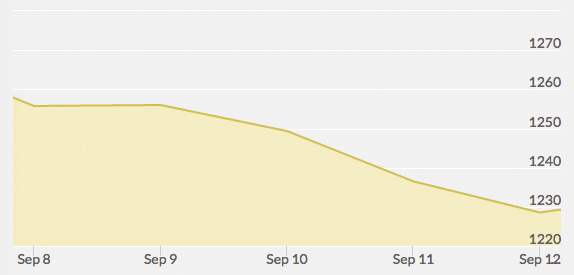
Open: $1,255.00 Close: $1,230.50 | High: $1,256.90 Low: $1,228.50
The week opened poorly for gold as the U.S. dollar continued to experience momentous gains. The yellow metal hit a three-month low on Monday, and then continued to weaken over the course of the week.
A stronger dollar means less urgency for investors to seek out gold as a safety fund. Without much noise in global politics this week, traders focused on the inverse relationship between gold and major currencies. Tuesday’s gold prices at first rose somewhat on short covering from the drop on Monday, but then sank again later in the day.
Overall, it was a quiet week. The dollar hit a 14-month high early in the week, while the euro sat at a 14-month low. The Russia-Ukraine cease-fire held strong, and forces began to retreat, which translated into no major moves for gold as a hedge fund. Wednesday hit another three-month low.
Thursday’s gold prices hit a seven-month low. With the U.S. dollar’ significant recovery lately, gold investors are worried that interest rates may rise soon.
Sellers have had the technical upperhand lately, due to 5 main key factors:
- Macroeconomic data from the U.S. has been positive, indicating an upward bound economy, which is bearish for gold.
- The U.S. dollar has been gaining positive upward momentum, which is inversely correlated to gold.
- Because of the economic stability in the U.S., investors anticipate a hike in interest rates, which generally pushes people toward interest-bearing assets and away from gold.
- The European Central Bank has been slashing interest rates, indicating a weaker euro, which actually strengthens the dollar, thus weakening gold.
- Geopolitical tensions in the Middle East and Ukraine have been easing, which means investors are not as keen on safety funds.
Friday closed the week on a 7.5-month low after a slow week, as investors look ahead to fresh indicators for the yellow metal.


